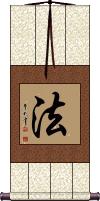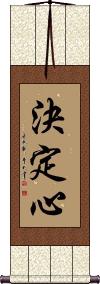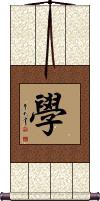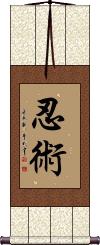Many custom options...
And formats...

Process in Chinese / Japanese...
Buy a Process calligraphy wall scroll here!
Personalize your custom “Process” project by clicking the button next to your favorite “Process” title below...
Dharma / The Law
法 is the simple way to write “law” or in a Buddhist context “Dharma.”
This can also mean method, way, or Buddhist teaching. It's also an abbreviation for the country of France.
The Buddhist context exists in Chinese and Korean Hanja but I have not yet confirmed that this means more than “law” when used alone in Japanese.
Resolute Mind
決定心 means the mind of certainty, resolute mind, imperturbable mind, firm determination, firm resolution, or stable commitment.
In the context of Buddhism, this is the deep resolution needed to attain enlightenment.
If you go to a deeper meaning, this is a condition of settling into the thought that occurs in the process of perception subsequent to the “seeking mind” or “尋求心.”
Seeker of Wisdom
尋智者 is a Chinese title that means “Seeker of Wisdom.”
It's a little ambiguous, as you can also read this as “Seeking a Wise Person.”
Whether you are the person seeking wisdom or in the process of seeking a wise person (you will probably gain wisdom from the wise) this short phrase should suit your needs.
Study / Learn / School
學 is “study” or “learn” in Chinese, Japanese Kanji, and old Korean Hanja.
學 is a very broad character that can mean a lot of things related to scholarship. It can refer to a school (in fact, if you put the character for “big” in front of this, you have “college” or “university,” if you put the word for “middle,” you have “middle school.” This can also mean science; the process of acquiring knowledge; learning; scholarship; erudition; knowledge. It can also add the Chinese or Japanese version of “-ology” (the study of) too many words.
![]() There is a very common simplified version of this character. You will see this form in modern Japan and mainland China, Singapore, and other places. If you want this simplified version, please click on the character shown to the right instead of the "select and customize" button above.
There is a very common simplified version of this character. You will see this form in modern Japan and mainland China, Singapore, and other places. If you want this simplified version, please click on the character shown to the right instead of the "select and customize" button above.
Phoenix Rise from the Ashes
鳳凰涅磐 is a proverb that suggests “Legendary Phoenix rises from the ashes.” It means “Legendary Phoenix [reaches] Nirvana.”
There is a legend in China of a great bird reborn once every 500 years. This bird gathers all the ill will, suffering, desire, and other negative things of the world. The bird then plunges into the fire to burn away all negative things, sacrificing itself in the process (achieving Nirvana, or perhaps allowing others the opportunity to reach Nirvana).
500 years later, the phoenix is reborn from the ashes again, and the cycle repeats.
Ninjutsu / Ninjitsu
忍術 is the “art of the ninja” in Japanese. Most Japanese people associate ninjas with romance and reverence for Japan's ancient past. But most will accept that the ninja is an idea or way of life whose time has passed. However, this has not stopped floods of movies about ninjas and dojos offering Ninjutsu training from keeping the idea of the ninja alive in modern times.
My modern Japanese dictionary defines this as “assassination, stealth, and combat techniques” or “fighting art of the ninja.”
![]() Note that when writing this as Kanji, Japanese tend to write the first character in the form shown to the right. Because this is specifically a Japanese title, we only suggest a Japanese calligrapher for this selection - and you will get the form shown to the right if you do that (please ignore the fact that some of the images you see during the following pages in the options process will be the Chinese/alternate form).
Note that when writing this as Kanji, Japanese tend to write the first character in the form shown to the right. Because this is specifically a Japanese title, we only suggest a Japanese calligrapher for this selection - and you will get the form shown to the right if you do that (please ignore the fact that some of the images you see during the following pages in the options process will be the Chinese/alternate form).
These search terms might be related to Process:
Practice / Train / Drill
Training / Practice / Cultivation
Not the results for process that you were looking for?
Below are some entries from our dictionary that may match your process search...
| Characters If shown, 2nd row is Simp. Chinese |
Pronunciation Romanization |
Simple Dictionary Definition |
學 学 see styles |
xué xue2 hsüeh manabu まなぶ |
More info & calligraphy: Study / Learn / School(personal name) Manabu śikṣ; to study, learn, the process of acquiring knowledge; learning. |
道 see styles |
dào dao4 tao wataru わたる |
More info & calligraphy: Daoism / Taoism(1) (abbreviation) (See 道・みち・1) road; path; street; route; (2) (See 道・みち・5) way; set of practices; rules for conducting oneself; (3) (abbreviation) (in Japanese schools) (See 道徳教育) moral education; (4) Buddhist teachings; (5) Taoism; (6) administrative region of Japan (Hokkaido); (7) (hist) administrative region of Japan (Tokaido, Tosando, etc.); (8) province (administrative region of Korea); (9) circuit (administrative region of China); (10) (hist) province (Tang-era administrative region of China); (personal name) Wataru mārga. A way, road; the right path; principle, Truth, Reason, Logos, Cosmic energy; to lead; to say. The way of transmigration by which one arrives at a good or bad existence; any of the six gati, or paths of destiny. The way of bodhi, or enlightenment leading to nirvāṇa through spiritual stages. Essential nirvāṇa, in which absolute freedom reigns. For the eightfold noble path v. 八聖道.; The two Ways: (1) (a) 無礙道 or 無間道 The open or unhindered way, or the way of removing all obstacles or intervention, i. e. all delusion; (b) 解脫道 the way of release, by realization of truth. (2) (a) 難行道 The hard way of "works", i. e. by the six pāramitā and the disciplines. (b) 易行道 the easy way salvation, by the invocation of Amitābha. (3) (a) 有漏道 The way of reincarnation or mortality; (b) 無漏 the enlightened way of escape from the miseries of transmigration. (4) (a) 教道 The way of instruction; (b) 證道 the way of realization. (5) The two lower excretory organs. |
感知 see styles |
gǎn zhī gan3 zhi1 kan chih kanchi かんち |
More info & calligraphy: Perception(noun, transitive verb) perception; sensing; noticing |
步 see styles |
bù bu4 pu bu |
a step; a pace; walk; march; stages in a process; situation (歩) pada; step, pace. |
段 see styles |
duàn duan4 tuan dan だん |
paragraph; section; segment; stage (of a process); classifier for stories, periods of time, lengths of thread etc (n,ctr) (1) step; stair; rung; (flight of) steps; (n,ctr) (2) shelf; layer; tier; (3) grade; level; class; (n,ctr) (4) dan (degree of advanced proficiency in martial arts, go, shogi, etc.); rank; (5) paragraph; passage; (n,ctr) (6) column (of print); (n,ctr) (7) act (in kabuki, joruri, etc.); section; scene; (8) row of the multiplication table (e.g. five times table); (9) stage (in a process); phase; occasion; time; moment; situation; (10) (form) (as ...の段) matter; occasion; (11) (as ...どころの段ではない, ...という段じゃない, etc.) degree; extent; (counter) (12) counter for breaks in written language or speech; (place-name, surname) Dan A piece; a section, paragraph. piṇda, a ball, lump, especially of palatable food, sustenance. |
緣 缘 see styles |
yuán yuan2 yüan en |
cause; reason; karma; fate; predestined affinity; margin; hem; edge; along pratyaya means conviction, reliance, but with Buddhists especially it means 'a co-operating cause, the concurrent occasion of an event as distinguished from its proximate cause'. M.W. It is the circumstantial, conditioning, or secondary cause, in contrast with 因 hetu, the direct or fundamental cause. hetu is as the seed, pratyaya the soil, rain, sunshine, etc. To reason, conclude. To climb, lay hold of. The mind 能緣can reason, the objective is 所緣, the two in contact constitute the reasoning process. The four kinds of causes are 因緣; 次第緣; 緣緣, and 增上緣 q.v. |
處 处 see styles |
chù chu4 ch`u chu tokoro ところ |
(bound form) place; locality; (bound form) part; aspect; (bound form) office; department; bureau; classifier for locations: spot, point (out-dated kanji) (n,suf) (1) place; spot; scene; site; (2) (kana only) address; (3) (kana only) district; area; locality; (4) (kana only) one's house; (5) (kana only) point; aspect; side; facet; (6) (kana only) passage (in text); part; (7) (kana only) space; room; (8) (kana only) thing; matter; (9) (kana only) whereupon; as a result; (10) (kana only) about to; on the verge of; (11) (kana only) was just doing; was in the process of doing; have just done; just finished doing; (surname) Tokoro To dwell, abide; fix, decide, punish; a place, state. āyatana, 阿耶怛那, also tr. 入, place or entrance of the sense, both the organ and the sensation, or sense datum; hence the 十二處 twelve āyatana, i. e. six organs, and six sense data that enter for discrimination. |
見 见 see styles |
xiàn xian4 hsien miru みる |
to appear; also written 現|现[xian4] (n-suf,n) (1) looking; viewing; (expression) (2) (colloquialism) (kana only) (after the -te form of a verb; irreg. imperative conj. of 見る) (See 見る・5) (please) try (to); (female given name) Miru darśana, 捺喇捨曩; also dṛṣṭi; seeing, discerning, judgment, views, opinions; it is thinking, reasoning, discriminating, selecting truth, including the whole process of deducing conclusions from premises. It is commonly used in the sense of wrong or heterodox views or theories, i. e. 邪見 or 有見, especially such as viewing the seeming as real and the ego as real. There are groups of two, four, five, seven, ten and sixty-two kinds of 見. |
轉 转 see styles |
zhuàn zhuan4 chuan utata うたた |
to revolve; to turn; to circle about; to walk about; classifier for revolutions (per minute etc): revs, rpm; classifier for repeated actions (surname) Utata vartana; pravartana; vṛtti. Turn, transform, revolve, evolve, change, the process of birth and rebirth; again, re-. |
三生 see styles |
sān shēng san1 sheng1 san sheng mitsuo みつお |
(surname, given name) Mitsuo The three births, or reincarnations, past, present, future. Tiantai has (a) 種 planting the seed; (b) 熟 ripening; (c) 脫 liberating, stripping, or harvesting, i.e. beginning, development, and reward of bodhi, a process either gradual or instantaneous. Huayan has (a) 見聞生 a past life of seeing and hearing Buddha-truth; (b) 解行生 liberation in the present life; (c) 證入生 realization of life in Buddhahood. This is also called 三生成佛, Buddhahood in the course of three lives. There is also a definition of three rebirths as the shortest term for arhatship, sixty kalpas being the longest. There are other definitions. |
三身 see styles |
sān shēn san1 shen1 san shen sanmi さんみ |
{Buddh} trikaya (three bodies of the Buddha); (surname) Sanmi trikāya. 三寶身 The threefold body or nature of a Buddha, i.e. the 法, 報, and 化身, or dharmakāya, sambhogakāya, and nirmāṇakāya. The three are defined as 自性, 受用, and 變化, the Buddha-body per se, or in its essential nature; his body of bliss, which he "receives" for his own "use" and enjoyment; and his body of transformation, by which he can appear in any form; i.e. spiritual, or essential; glorified; revealed. While the doctrine of the trikāya is a Mahāyāna concept, it partly results from the Hīnayāna idealization of the earthly Buddha with his thirty-two signs, eighty physical marks, clairvoyance, clairaudience, holiness, purity, wisdom, pity, etc. Mahāyāna, however, proceeded to conceive of Buddha as the Universal, the All, with infinity of forms, yet above all our concepts of unity or diversity. To every Buddha Mahāyāna attributed a three-fold body: that of essential Buddha; that of joy or enjoyment of the fruits of his past saving labours; that of power to transform himself at will to any shape for omnipresent salvation of those who need him. The trinity finds different methods of expression, e.g. Vairocana is entitled 法身, the embodiment of the Law, shining everywhere, enlightening all; Locana is 報身; c.f. 三賓, the embodiment of purity and bliss; Śākyamuni is 化身 or Buddha revealed. In the esoteric sect they are 法 Vairocana, 報 Amitābha, and 化 Śākyamuni. The 三賓 are also 法 dharma, 報 saṅgha, 化 buddha. Nevertheless, the three are considered as a trinity, the three being essentially one, each in the other. (1) 法身 Dharmakāya in its earliest conception was that of the body of the dharma, or truth, as preached by Śākyamuni; later it became his mind or soul in contrast with his material body. In Mādhyamika, the dharmakāya was the only reality, i.e. the void, or the immateria1, the ground of all phenomena; in other words, the 眞如 the tathāgatagarbha, the bhūtatathatā. According to the Huayan (Kegon) School it is the 理or noumenon, while the other two are氣or phenomenal aspects. "For the Vijñānavāda... the body of the law as highest reality is the void intelligence, whose infection (saṃkleҫa) results in the process of birth and death, whilst its purification brings about Nirvāṇa, or its restoration to its primitive transparence" (Keith). The "body of the law is the true reality of everything". Nevertheless, in Mahāyāna every Buddha has his own 法身; e.g. in the dharmakāya aspect we have the designation Amitābha, who in his saṃbhogakāya aspect is styled Amitāyus. (2) 報身Sambhogakāya, a Buddha's reward body, or body of enjoyment of the merits he attained as a bodhisattva; in other words, a Buddha in glory in his heaven. This is the form of Buddha as an object of worship. It is defined in two aspects, (a) 自受用身 for his own bliss, and (b) 他受用身 for the sake of others, revealing himself in his glory to bodhisattvas, enlightening and inspiring them. By wisdom a Buddha's dharmakāya is attained, by bodhisattva-merits his saṃbhogakāya. Not only has every Buddha all the three bodies or aspects, but as all men are of the same essence, or nature, as Buddhas, they are therefore potential Buddhas and are in and of the trikāya. Moreover, trikāya is not divided, for a Buddha in his 化身 is still one with his 法身 and 報身, all three bodies being co-existent. (3) 化身; 應身; 應化身 nirmāṇakāya, a Buddha's transformation, or miraculous body, in which he appears at will and in any form outside his heaven, e.g. as Śākyamuni among men. |
上る see styles |
agaru あがる |
(v5r,vi) (1) to ascend; to go up; to climb; (2) to ascend (as a natural process, e.g. the sun); to rise; (3) to go to (the capital); (4) to be promoted; (5) to add up to; (6) to advance (in price); (7) to swim up (a river); to sail up; (8) to come up (on the agenda); (irregular okurigana usage) (v5r,vi) (1) to rise; to go up; to come up; to ascend; to be raised; (2) to enter (esp. from outdoors); to come in; to go in; (3) to enter (a school); to advance to the next grade; (4) to get out (of water); to come ashore; (5) to increase; (6) to improve; to make progress; (7) to be promoted; to advance; (8) to be made (of profit, etc.); (9) to occur (esp. of a favourable result); (10) to be adequate (to cover expenses, etc.); (11) to be finished; to be done; to be over; (12) (of rain) to stop; to lift; (13) to stop (working properly); to cut out; to give out; to die; (14) to win (in a card game, etc.); (15) to be spoken loudly; (16) to get stage fright; (17) to be offered (to the gods, etc.); (18) (humble language) to go; to visit; (19) (honorific or respectful language) to eat; to drink; (20) to be listed (as a candidate); (21) to serve (in one's master's home); (22) to go north; (suf,v5r) (23) indicates completion; (place-name) Agaru |
乳突 see styles |
rǔ tū ru3 tu1 ju t`u ju tu |
mastoid process |
交由 see styles |
jiāo yóu jiao1 you2 chiao yu |
to hand over (responsibility for something) to (sb); to leave it to (sb else to take charge of the next stage of a process) |
佛土 see styles |
fó tǔ fo2 tu3 fo t`u fo tu butsudo |
buddhakṣetra. 佛國; 紇差怛羅; 差多羅; 刹怛利耶; 佛刹 The land or realm of a Buddha. The land of the Buddha's birth, India. A Buddha-realm in process of transformation, or transformed. A spiritual Buddha-realm. The Tiantai Sect evolved the idea of four spheres: (1) 同居之國土 Where common beings and saints dwell together, divided into (a) a realm where all beings are subject to transmigration and (b) the Pure Land. (2) 方便有餘土 or 變易土 The sphere where beings are still subject to higher forms of transmigration, the abode of Hīnayāna saints, i.e. srota-āpanna 須陀洹; sakṛdāgāmin 斯陀含; anāgāmin 阿那含; arhat 阿羅漢. (3) 實報無障礙 Final unlimited reward, the Bodhisattva realm. (4) 常寂光土 Where permanent tranquility and enlightenment reign, Buddha-parinirvāṇa. |
作用 see styles |
zuò yòng zuo4 yong4 tso yung sayou / sayo さよう |
to act on; to affect; action; function; activity; impact; result; effect; purpose; intent; (suffix) -ation, -tion etc, as in 抑制作用[yi4 zhi4 zuo4 yong4], inhibition (n,vs,vi) action; operation; process; agency; effect; function Function, activity, act. |
修惑 see styles |
xiū huò xiu1 huo4 hsiu huo shuwaku しゅわく |
{Buddh} perceptive mental disturbances Illusion, such as desire, hate, etc., in practice or performance, i.e. in the process of attaining enlightenment; cf. 思惑. |
初品 see styles |
shohin しょひん |
initial parts; first article; first off-tool parts (from a manufacturing process) |
加工 see styles |
jiā gōng jia1 gong1 chia kung kakou / kako かこう |
to process; processing; working (of machinery) (noun, transitive verb) manufacturing; processing; treatment; machining |
參選 参选 see styles |
cān xuǎn can1 xuan3 ts`an hsüan tsan hsüan |
to be a candidate in an election or other selection process; to run for office; to turn out to vote |
友禅 see styles |
yuuzen / yuzen ゆうぜん |
(abbreviation) (See 友禅染) type of dyeing method or pattern; silk printed by the Yuzen process; (personal name) Yūzen |
報檢 报检 see styles |
bào jiǎn bao4 jian3 pao chien |
to submit goods for inspection, quarantine or certification; to register oneself to be examined (as part of a certification process) |
塑像 see styles |
sù xiàng su4 xiang4 su hsiang sozou / sozo そぞう |
to sculpt or mold a statue (by shaping a pliable material such as clay, plaster or wax, which may later be cast in metal – as distinct from carving in stone or wood); a statue created through such a process plaster image; clay figure To model images. |
壞法 坏法 see styles |
huài fǎ huai4 fa3 huai fa ehō |
Any process of destruction, or decay to burn the bones of a deceased person so that they may not draw him to rebirth. |
始覺 始觉 see styles |
shǐ jué shi3 jue2 shih chüeh shigaku |
The initial functioning of mind or intelligence as a process of 'becoming', arising from 本覺 which is Mind or Intelligence, self-contained, unsullied, and considered as universal, the source of all enlightenment. The 'initial intelligence' or enlightenment arises from the inner influence 薰 of the Mind and from external teaching. In the 'original intelligence' are the four values adopted and made transcendent by the Nirvāṇa-sūtra, viz. 常, 樂, 我, 淨 Perpetuity, joy, personality, and purity; these are acquired through the 始覺 process of enlightenment. Cf. 起信論 Awakening of Faith. |
工序 see styles |
gōng xù gong1 xu4 kung hsü |
working procedure; process |
工程 see styles |
gōng chéng gong1 cheng2 kung ch`eng kung cheng koutei / kote こうてい |
engineering; an engineering project; project; undertaking; CL:個|个[ge4],項|项[xiang4] process; operation; stage of a process; progress of work |
径路 see styles |
keiro / kero けいろ |
(1) course; route; path; channel; (2) process; means |
手続 see styles |
tetsuzuki てつづき |
(noun/participle) procedure; (legal) process; formalities |
手順 see styles |
tejun てじゅん |
process; procedure; sequence; protocol; instruction |
Click here for more process results from our dictionary
The following table may be helpful for those studying Chinese or Japanese...
| Title | Characters | Romaji (Romanized Japanese) | Various forms of Romanized Chinese | |
| Dharma The Law | 法 | hou / ho | fǎ / fa3 / fa | |
| Resolute Mind | 決定心 决定心 | ketsujou shin ketsujoushin ketsujo shin | jué dìng xīn jue2 ding4 xin1 jue ding xin juedingxin | chüeh ting hsin chüehtinghsin |
| Seeker of Wisdom | 尋智者 寻智者 | xún zhì zhě xun2 zhi4 zhe3 xun zhi zhe xunzhizhe | hsün chih che hsünchihche |
|
| Study Learn School | 學 学 | gaku | xué / xue2 / xue | hsüeh |
| Phoenix Rise from the Ashes | 鳳凰涅磐 凤凰涅磐 | fèng huáng niè pán feng4 huang2 nie4 pan2 feng huang nie pan fenghuangniepan | feng huang nieh p`an fenghuangniehpan feng huang nieh pan |
|
| Ninjutsu Ninjitsu | 忍術 忍术 | ninjutsu | rěn shù / ren3 shu4 / ren shu / renshu | jen shu / jenshu |
| In some entries above you will see that characters have different versions above and below a line. In these cases, the characters above the line are Traditional Chinese, while the ones below are Simplified Chinese. | ||||
Successful Chinese Character and Japanese Kanji calligraphy searches within the last few hours...









